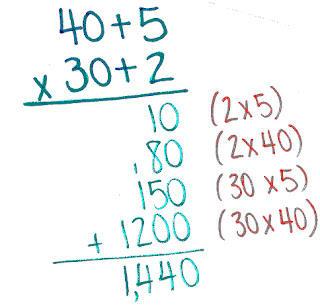Multiplication Cluster
This strategy of decomposing one of the factors has empowered students to learn how to solve problems using mental mathematics. It has reinforced the concept of multiplication in that one factor represents the size of groups while the other factor represents the number of groups.
Open Array Model
This model has been fantastic as we have made sense of multiplication with larger factors because it has helped us not lose sight of the value of each factor and it has enabled us to decompose BOTH factors and keep track of finding all of the needed partial products.
Transition to the Traditional Algorithm
Recent efforts in math have been to use this model (which also decomposes both factors like the open array does) to understand how and why the traditional algorithm works. With this model, we practice multiplying in the same order that is used with the algorithm, but without the succinct regrouping. *Notice that the SAME four smaller problems solved here match the four smaller problems in the open array model above. These SAME four smaller problems are also calculated in our heads when using the traditional algorithm (below) too!
Traditional Algorithm
Aah......our final destination. Now that we have explored the concept of multiplication so deeply, we feel our students are ready to truly understand how and why this succinct strategy works. They must be able to explain it, though, if they are to use it as a primary strategy in class.
Can you see how all of these strategies are related? :-)
Can you see how all of these strategies are related? :-)
Deep conceptual understanding is realized when one can solve a problem in multiple ways and make connections between strategies and models in how they are related and why they work. Mathematical conversations have never been more fun!





I like to do opean arry model. It is easy to do for me
ReplyDeleteJordan S.
the traditional algorithm is my favorite because it is as simple as pie . and does not take up much space on the paper...
ReplyDeleteAUDREY W
the generic rectangle really helped me and it was the most efficient strategy but now that i know the multiplication algorithm i can do an even more efficient strategy.
ReplyDeleteAshley